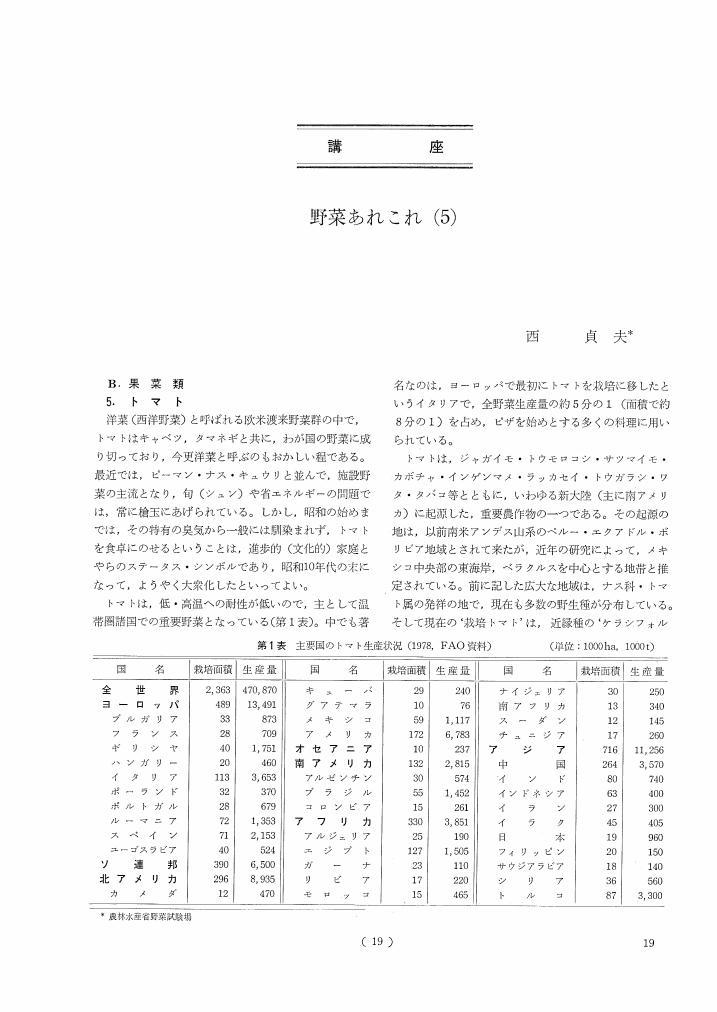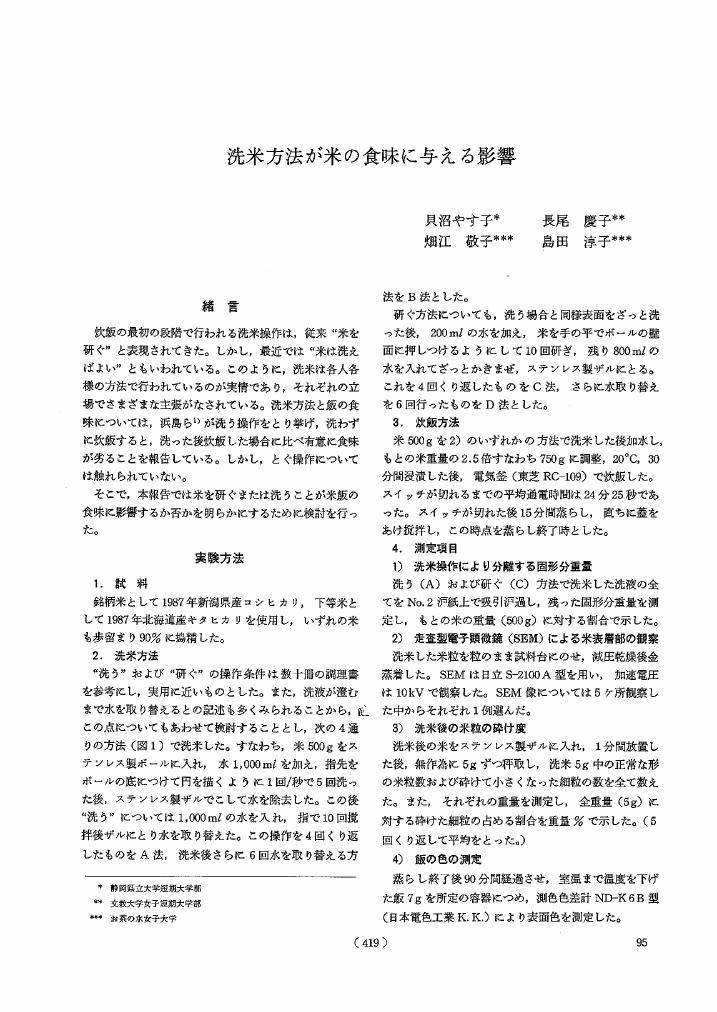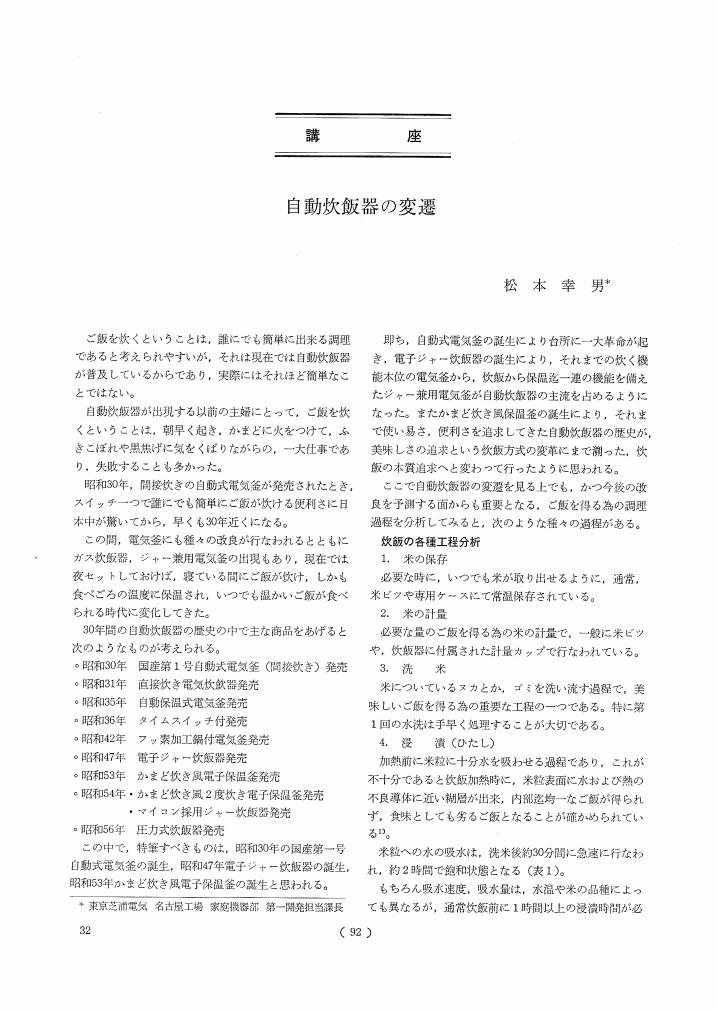3 0 0 0 OA 卵白によるスープの清澄効果について : 第2報 : 卵白とひき肉の併用効果
- 著者
- 猪俣 美知子 河村 フジ子
- 出版者
- 一般社団法人日本調理科学会
- 雑誌
- 調理科学 (ISSN:09105360)
- 巻号頁・発行日
- vol.15, no.2, pp.100-103, 1982-06-20
- 被引用文献数
- 3
透明度の高いスープを得る手法として、卵白とひき肉を併用することの効果とその要領について検討した結果を要約すると次のようになる。1) 30℃の原液に、卵白とひき肉を混合し、70℃まで攪拌しつつ温度を上げ、以後そのまま加熱し,94±1℃で10分以上保つと透明なスープが得られる。 2) 卵白量が1%でも、ひき肉を併用すると顕著に透明度は高くなる。しかし、ひき肉量に対して卵白量が多すぎると、pHが上昇し、スープの透明度は低下する。 3) 脂肪の多いひき肉や多量の脂肪がエマルジョン状となって分散している原液の場合も、卵白とひき肉の併用効果は顕著である。ただし、この場合は、脂肪の一部が油滴となって表面に浮上してくる。
3 0 0 0 OA 食肉のマリネに関する研究 : 筋原繊維蛋白質の分解を中心として
- 著者
- 妻鹿 絢子 藤木 澄子 細見 博子
- 出版者
- 一般社団法人日本調理科学会
- 雑誌
- 調理科学 (ISSN:09105360)
- 巻号頁・発行日
- vol.13, no.3, pp.197-202, 1980-10-30
- 被引用文献数
- 2
1.市販牛角切り肉を1.5%酢酸溶液に5℃で40時間浸漬するマリネ処理により,官能的にも物理的測定からも肉がやわらかくなることが認められた。同時にマリネ処理肉のpHは4.5付近を示し,肉重量が増加した。2.同様のマリネ処理により,筋原繊維蛋白質中の分子量220,000daltonのミオシンが,150,000daltonfragmentすなわちHMMへと分解した。この時のミオシン分解率は肉中心部で22.3%,肉表層部で44.5%を示し,牛肉ホモジネートをp4.0に調整し,5℃で40時間インキュベートしたモデル実験におけるミオシン分解率46.9%にほぼ一致した。3。肉ホモジネートをpH4.0でインキュベートした場合,水溶性蛋白質が分解し,低分子窒素化合物が増加することが認められた。角切り肉をマリネ処理した場合には,蛋白質の分解により生成した比較的高分子の窒素化合物は肉中に保存され,低分子の窒素化合物は浸漬液中に溶出した。おわりに本研究を行うにあたり終始ご懇篤なる御指導御校閲を賜わりましたお茶の水女子大学荒川信彦教授に厚く御礼を申し上げます。
2 0 0 0 OA 鯉料理と山形
- 著者
- 富江 ハス子
- 出版者
- 一般社団法人 日本調理科学会
- 雑誌
- 調理科学 (ISSN:09105360)
- 巻号頁・発行日
- vol.18, no.2, pp.109-113, 1985-07-20 (Released:2013-04-26)
- 参考文献数
- 5
- 被引用文献数
- 1
2 0 0 0 OA 各種製茶の煎出条件とカフェイン・タンニン溶出量及び味との関係
- 著者
- 米田 泰子 加藤 佐千子
- 出版者
- 一般社団法人 日本調理科学会
- 雑誌
- 調理科学 (ISSN:09105360)
- 巻号頁・発行日
- vol.27, no.1, pp.31-38, 1994-02-20 (Released:2013-04-26)
- 参考文献数
- 11
- 被引用文献数
- 4
In order to discover the correlation between the concentration of caffeine and tannin released by brewing tea and the result of the palatability, as for gyokuro, sencha, mizudasisencha, hojicha, bancha, oolong-tea, we brewed each tea three times and measured the amounts of caffeine and tannin in each different brewing period.1. Gyokuro; The second infusion exuded more caffeine and tannin when it was steeped for 0.5,1,2,3 minutes. And the first infusion exuded more when it was steeped 4 minutes. But in the palatability of each brewing tea there were little differences on the degree of bitterness and astringency. The total taste of the first infusion was the strongest and most preferred.2. Sencha; The second infusion exuded the most caffeine and tannin when it was steeped for 0.5,1 minute. The first infusion exuded them most when it was steeped for 3 or 4 minutes. The bitterness and astringency in the first infusion were as mush as the second infusion and in the third infusion were weaker. The more the tea was rebrewed the weaker the taste got.3. Hojicha, bancha; The first infusion exuded more caffeine and tannin (except 0.5,1 minutes steeped one), and the bitterness and astringency were stronger.4. Oolong-tea; As for the concentration of caffeine and tannin the result was the same as hojicha, bancha. The first infusion with the strongest total taste was not preferred. The second one seemed to be favoured.5. The lower quality teas have a positive correlation between the concentration of caffeine and tannin and bitterness, astringency, umami and popularity. Their tastes seem to be more affected by the concentration of caffeine and tannin. Oolong-tea has a negative correlation between the popularity and the concentration of caffeine and tannin.
2 0 0 0 OA 野菜あれこれ(5)
- 著者
- 西 貞夫
- 出版者
- 一般社団法人 日本調理科学会
- 雑誌
- 調理科学 (ISSN:09105360)
- 巻号頁・発行日
- vol.14, no.1, pp.19-26, 1981-02-20 (Released:2013-04-26)
2 0 0 0 OA 食品の嗜好に関する研究(第3報)
- 著者
- 高橋 史人 山口 和子
- 出版者
- 一般社団法人 日本調理科学会
- 雑誌
- 調理科学 (ISSN:09105360)
- 巻号頁・発行日
- vol.18, no.4, pp.259-268, 1985-12-20 (Released:2013-04-26)
- 参考文献数
- 6
- 被引用文献数
- 1
The authors have made investigation into about five thousands men and women aged above twelve all over Japan in 1978,1980 and 1982 in order to find structures of food preference.The investigation was made by self-writing method to evaluate individual preference on about one hundred fifty kinds of dishes and foods, and thirty four kinds of strength of taste and type of textures. For preference on dishes and food, five-point scale was adopted. On the contrary, paired choice was adopted for strength of taste and type of texture.Two papers in terms of this study were already published. Main results of this paper are as follows.(1) The largest factor which affects food preference is age. And age characteristics have been analyzed by the common preference factors found in prior studies. Take teenagers for an example, their characteristics are dislike of “Japanese foods” and like of “Western and heavy foods”.(2) Area characteristics have been analyzed by the common preference factors. Take Kanto area for an example, its characteristics are “Western and spicy tastes”.(3) To find how food preference changes according to age, likes and dislikes of the common preference factors and of the forty-two foods composed of those factors were studied. For example, the foods of “Japanese” factor become prefered as age goes up, while the food of “Western” factor have the opposite tendency. The terning point of preference on the foods of “Japanese” factor is the thirties and that of “Western” factor is the forties.(4) The similarity among the area characteristics, of the food preference seen in the eight areas in Japan were found out. The food preference of Tohoku area is similar to that of Hokkaido, and so is Hokuriku to Tokai.
2 0 0 0 OA 電子レンジによる食品の調理に関する研究
- 著者
- 堀越 フサエ
- 出版者
- 一般社団法人 日本調理科学会
- 雑誌
- 調理科学 (ISSN:09105360)
- 巻号頁・発行日
- vol.4, no.3, pp.128-140, 1971-09-20 (Released:2013-04-26)
2 0 0 0 OA 洗米方法が米の食味に与える影響
- 著者
- 貝沼 やす子 長尾 慶子 畑江 敬子 島田 淳子
- 出版者
- 一般社団法人 日本調理科学会
- 雑誌
- 調理科学 (ISSN:09105360)
- 巻号頁・発行日
- vol.23, no.4, pp.419-423, 1990-11-20 (Released:2013-04-26)
- 参考文献数
- 3
- 被引用文献数
- 11
2 0 0 0 OA 手延素麺
- 著者
- 小川 玄吾
- 出版者
- 一般社団法人 日本調理科学会
- 雑誌
- 調理科学 (ISSN:09105360)
- 巻号頁・発行日
- vol.18, no.1, pp.11-16, 1985-03-20 (Released:2013-04-26)
- 参考文献数
- 12
- 被引用文献数
- 1
2 0 0 0 OA 味噌の調理
- 著者
- 伊東 清枝
- 出版者
- 一般社団法人 日本調理科学会
- 雑誌
- 調理科学 (ISSN:09105360)
- 巻号頁・発行日
- vol.1, no.2, pp.75-79, 1968-07-25 (Released:2013-04-26)
- 参考文献数
- 10
2 0 0 0 OA 炊飯米に対する本みりんの添加効果について
- 著者
- 奥田 和子 渡邊 裕季子 倉賀野 妙子 河辺 達也 長浜 源壮 森田 日出男
- 出版者
- 一般社団法人 日本調理科学会
- 雑誌
- 調理科学 (ISSN:09105360)
- 巻号頁・発行日
- vol.23, no.1, pp.81-85, 1990-02-20 (Released:2013-04-26)
- 参考文献数
- 13
- 被引用文献数
- 4
The palatability and rheological properties of rice cooked in water and in Hon-Mirin solution was compared. The concentration of Hon-Mirin, used was 1.7%.Sensory evaluation showed that rice cooked in Hon-Mirin solution was more favourable than rice cooked in water on the appearance, stickiness, hardness, umami and total acceptance.Force-time curves of rices cooked in these conditions were examined under compression at a constant speed. When cooked in Hon-Mirin solution, initial elasticity and total and adhesive energies of the rice were greater than those of rice cooked in water.It was found that rice cooked in Hon-Mirin solution had higher falling speed in water than that of rice cooked in water. Supposedly the smooth surface of the former rice caused increase of falling speed. There were no differences on the moisture and the specific gravity between two cooked rices.
2 0 0 0 OA 野菜あれこれ(7)
- 著者
- 西 貞夫
- 出版者
- 一般社団法人 日本調理科学会
- 雑誌
- 調理科学 (ISSN:09105360)
- 巻号頁・発行日
- vol.15, no.1, pp.24-32, 1982-04-20 (Released:2013-04-26)
2 0 0 0 OA 調理とコロイド(3)
- 著者
- 金谷 昭子
- 出版者
- 一般社団法人 日本調理科学会
- 雑誌
- 調理科学 (ISSN:09105360)
- 巻号頁・発行日
- vol.23, no.3, pp.254-258, 1990-08-20 (Released:2013-04-26)
2 0 0 0 OA 自動炊飯器の変遷
- 著者
- 松本 幸男
- 出版者
- 一般社団法人 日本調理科学会
- 雑誌
- 調理科学 (ISSN:09105360)
- 巻号頁・発行日
- vol.15, no.2, pp.92-96, 1982-06-20 (Released:2013-04-26)
- 参考文献数
- 3
2 0 0 0 OA ほうれんそうをゆでる
- 著者
- 河村 フジ子
- 出版者
- 一般社団法人 日本調理科学会
- 雑誌
- 調理科学 (ISSN:09105360)
- 巻号頁・発行日
- vol.19, no.3, pp.190-192, 1986-12-20 (Released:2013-04-26)
- 参考文献数
- 2
- 被引用文献数
- 1
2 0 0 0 OA かてもの
- 著者
- 高垣 順子
- 出版者
- 一般社団法人 日本調理科学会
- 雑誌
- 調理科学 (ISSN:09105360)
- 巻号頁・発行日
- vol.6, no.3, pp.185-190, 1973-09-10 (Released:2013-04-26)
2 0 0 0 OA 紅茶の水色変化におけるpHおよび有機酸の影響
- 著者
- 下橋 淳子 寺田 和子
- 出版者
- 一般社団法人 日本調理科学会
- 雑誌
- 調理科学 (ISSN:09105360)
- 巻号頁・発行日
- vol.25, no.3, pp.222-227, 1992-08-20 (Released:2013-04-26)
- 参考文献数
- 8
- 被引用文献数
- 1
Effects of pH and organic acids on the color of infusion of black tea have been studied by color measurement and pigment separation.The color of infusion of black tea became brighter orange with lower value of pH and more reddish brown with higher value of pH.Infusion with buffers of pH 2.2-8.0 showed that optical density of butanol and water layers increased with higher pH in comparison with Methyl-iso-butylketone layer.Methyl-iso-butylketone layer which mainly contains theaflavins, had higher optical density with lower value of pH and lower optical density with higher value of pH. Butanol layer which mainly contains thearubigins, and water layer which contains water soluble pigment, had higher optical density with increase of pH.When the 2-4×10-5 mol of acetic acid, lactic acid, gallic acid, oxalic acid, malic acid, succinic acid, tartaric acid or citric acid was added to the infusion of black tea, the different effect on the color was not recognized.Ascorbic acid had the effect of increasing yellow and rising the value and chroma of the infusion of black tea in comparison with other organic acids.It is considered that the change of color of infusion of black tea, by adding lemon, is due to ascorbic acid and the decrease of pH.
2 0 0 0 OA 組織状大豆たん白食品の歩み
- 著者
- 菊池 三郎
- 出版者
- 一般社団法人 日本調理科学会
- 雑誌
- 調理科学 (ISSN:09105360)
- 巻号頁・発行日
- vol.20, no.4, pp.308-318, 1987-12-20 (Released:2013-04-26)
2 0 0 0 OA 食用花の成分
- 著者
- 高宮 和彦 阿部 真帆 犬塚 郁子 大河原 歩美 大野 敦子
- 出版者
- 一般社団法人 日本調理科学会
- 雑誌
- 調理科学 (ISSN:09105360)
- 巻号頁・発行日
- vol.24, no.1, pp.32-35, 1991-02-20 (Released:2013-04-26)
- 参考文献数
- 15
- 被引用文献数
- 1
2 0 0 0 OA 会津の郷土料理, つと豆腐の日持ちについて
- 著者
- 菊池 節子 鍬野 信子 佐原 昊 近藤 榮昭
- 出版者
- 一般社団法人日本調理科学会
- 雑誌
- 調理科学 (ISSN:09105360)
- 巻号頁・発行日
- vol.20, no.4, pp.337-340, 1987-12-20
会津の郷土料理、つと豆腐について、市販豆腐の包装方法と同様に包装し、5℃±5℃の冷蔵庫で保存してその保存性について検討を加えた。その結果、次のような知見を得た。1. 官能検査の結果、保存5日目に品質の劣化が認められた。2. つと豆腐の色は、保存により次第に黄味を帯びる傾向にあったが、品質劣化には大きな影響を与える因子とは考えられなかった。3. 食感は、官能検査結果では4日目から有意な差が認められたが、カードメーターによる硬さにおいて、差は認められなかった。4. つと豆腐浸漬液の吸光度は、日数の経過とともに大きな値を示し、日持ちの判定の一つの指標になるものと思われた。5. pHは、保存にともない低下する傾向を示した。















